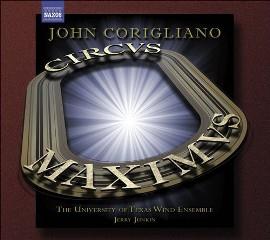John Corigliano – Circus Maximus (2009)
John Corigliano – Circus Maximus (2009)

Circus Maximus: Symphony No. 3 For Large Wind Ensemble (2004) (35:43) 1 Introitus 3:27 2 Screen/Siren 4:48 3 Channel Surfing 5:03 4 Night Music I 6:41 5 Night Music II 4:00 6 Circus Maximus 4:05 7 Prayer 5:59 8 Coda: Veritas 1:40 Gazebo Dances For Band (1972) (17:06) 9 Overture 4:49 10 Waltz 2:57 11 Adagio 6:36 12 Tarantella 2:34 The University Of Texas Wind Ensemble Jerry Junkin - conductor
This disc contains two works for wind ensembles, one large-scale and one smaller. The first, Circus Maximus, is a named symphony for wind ensemble, though its performance is much more complex than it seems. It was written for three wind bands: a “stage band”, a “surround band” and a marching band. It’s conceived as a work that moves both through time and space - a diagram in the notes shows how the different groups are intended to be set up.
The music has clear Ivesian influences. It starts with a raucous attack, and when the music gets quieter, such as during the third movement, “Channel Surfing”, there are sections when a band leaps out at the listener. Other movements, such as the two Night Music parts, are more subtle and very soft, providing just wisps of music in an impressionistic style that brings to mind wild animals in the wind.
The writing is a combination of tonal and atonal, with melodic snippets that remind the listener of a wide range of musics. Corigliano planned this work as a sort of statement about modern society, and in a way it is an example of what music can do wrong. By satirizing the excesses of today, and paralleling them with the excesses of imperial Rome, he ends up with a piece that is neither here nor there. It sounds more like a catalogue of sound ideas than a coherent work.
The composer says this about the piece: “The parallels between the high decadence of Rome and our present time are obvious. Entertainment dominates our culture, and ever-more-extreme ‘reality’ shows dominate our entertainment. Many of us have become as bemused by the violence and humiliation that flood the 500-plus channels of our television screens as those mobs of imperial Rome who considered the devouring of human beings by starving lions just another Sunday show.”
This is all fine, but a programmatic symphony about reality TV and the evils of modern society seems to be an odd proposal, and the music gives few hints as to this hidden program.
The work is ambitious, however, in ways that cannot come across in the recording. Again, most likely influenced by Charles Ives - who loved the sounds of different marching bands playing different music and crossing each other in the street - Corigliano conceived of this as a spatial piece. For example, in his notes, he says that, for the sixth movement, there is a “band marching down the aisles”. There is a Blu-Ray audio version of this work, which would give a much better idea of these spatial aspects, but I only have the CD to listen to, so many of those elements are lost.
Oh, and it ends with a gunshot; there seems to be something deep about that, but I need to listen to the gunshot many more times to grasp it.
The second work, Gazebo Dances, is an arrangement of a set of four-hand piano pieces originally written in 1972. The sound here is oddly much more like what one would expect from a wind band. Not having heard the piano versions, I can’t imagine how they would sound for that instrument. They are attractive pieces, with little pretension, and the arrangements are delightful. This music sounds fun, and these four brief episodes make a very nice suite. There’s a bit of the circus to them - not the ‘maximus’ kind, but the one with rings - and they are light and pleasant to listen to.
This disc will most likely appeal to those with a special affinity for wind ensembles and bands. While the two works are very different, they do show a composer who has written some interesting music. ---Kirk McElhearn, musicweb-international.com
download (mp3 @320 kbs):
yandex mediafire ulozto gett bayfiles








